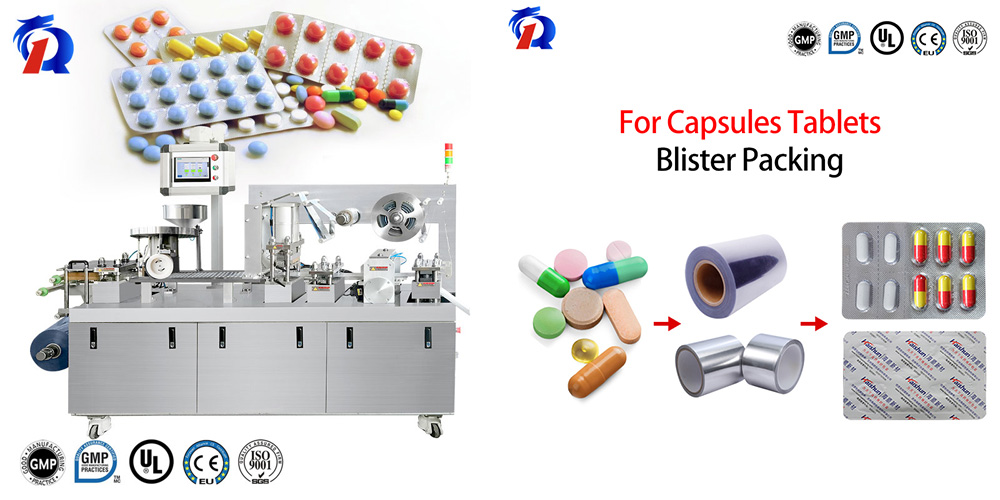Categories
New Blog
Tags
In the pharmaceutical industry, choosing the right blister packaging machine is crucial for ensuring product safety, efficacy, and market competitiveness. Blister packaging not only protects medications from environmental factors but also enhances the packaging's aesthetic appeal and brand image. How can you select a machine that meets industry requirements while fitting your specific product needs? This article will focus on the selection of blister packaging machines for the pharmaceutical sector, helping you find the ideal equipment for your production line.

A blister packaging machine is a device that seals medications or other items in transparent plastic blisters. The forming, filling, and sealing of the blisters are all done automatically, creating sealed packaging units. For pharmaceutical companies, blister packaging not only protects products but also instills confidence in consumers by allowing them to clearly see the product inside.
Blister packaging machines generally operate in three main steps: forming, filling, and sealing. First, the plastic sheet is heated to become pliable, then it is molded into the shape of a blister; next, the machine automatically fills the blister with medication; finally, a sealing agent is applied to firmly attach the blister to the backing material. These processes are controlled by automation, greatly enhancing efficiency and accuracy in packaging.
Product Protection
In the pharmaceutical sector, the primary function of blister packaging is to safeguard medications. Packaging must provide moisture and contamination barriers to ensure the safety and effectiveness of drugs throughout their shelf life. The airtight seal of blister packaging effectively blocks moisture, air, and light, preventing oxidation and spoilage, which is vital for preserving product integrity. For certain medications sensitive to humidity and air, blister packaging is essential.
Enhancing Production Efficiency
Modern blister packaging machines are highly automated, significantly improving production efficiency. Pharmaceutical packaging often involves high volumes, and automated blister packaging machines can quickly and continuously handle large-scale tasks, reducing manual labor and the risk of human error. The ability to swiftly switch between different medication specifications means you can flexibly adjust production plans, adapting more efficiently to market demand changes.
Selecting the right blister packaging machine requires careful consideration of several factors, as different machines serve different purposes. Here are the key aspects to focus on:
Suitable Packaging Materials
Common materials used in pharmaceutical packaging include PVC, PVDC, and aluminum foil. Each material has different barrier properties and cost implications. PVC is more economical but offers lower moisture resistance; PVDC provides better moisture and oxidation protection; while aluminum foil offers superior sealing capabilities. Choosing the right material is crucial for protecting your medication, so you must ensure that the machine can process the selected materials effectively.
Adaptability
The machine should accommodate various types of medications, including tablets, capsules, and ointments. A versatile machine can handle different shapes and sizes of products, ensuring that packaging tasks proceed smoothly without jams or waste.
Forming Accuracy
The blisters must be accurately formed to keep medications securely positioned within the packaging. This is not just a matter of appearance but also a safety concern. High-precision forming technology minimizes packaging deviations, reducing waste and ensuring consistent quality across batches.
Filling Precision
Filling medications must be done with precision to prevent discrepancies in quantity. Quality blister packaging machines usually come equipped with precise filling systems that monitor the filling process, ensuring compliance with pharmaceutical standards and maintaining customer trust.
Ease of Cleaning
The pharmaceutical industry imposes strict hygiene standards on equipment. Blister packaging machines should be easy to clean to minimize downtime and prevent cross-contamination risks. A design that allows for quick disassembly and thorough cleaning is essential for ensuring product safety.
Maintenance Requirements
Regular maintenance directly impacts machine lifespan and production efficiency. A well-designed blister packaging machine is built for durability, reducing the frequency and cost of maintenance. For pharmaceutical companies, minimizing machine downtime is vital for boosting overall production efficiency.
Global Brands
The market for pharmaceutical packaging equipment features several leading brands that provide high-quality blister packaging machines. These companies often have significant technological expertise, particularly in automation, precision, and efficiency, making their products more competitive. Choosing a reputable brand can also ensure better after-sales service, which is important for addressing any issues that may arise during machine operation.
Technological Innovation
As the pharmaceutical industry evolves, blister packaging machines continue to innovate. Many brands invest heavily in smart and digital technologies, employing sensors, data analytics, and intelligent control systems to help customers optimize production processes, enhancing both stability and flexibility. These innovations can lead to improved energy efficiency and higher product quality.
Overview of Rich Packing
Rich Packing is a renowned Chinese brand specializing in pharmaceutical packaging equipment, dedicated to providing innovative packaging solutions to clients worldwide. Their extensive product line includes a variety of packaging types, with the DPP-270Max blister packaging machine specifically designed for the pharmaceutical sector.
Features of the DPP-270Max Blister Packaging Machine
The DPP-270Max machine features advanced forming and filling systems that ensure precision in every blister package. Its intelligent control system monitors production data in real-time, enabling quick identification and resolution of issues. The user-friendly interface makes it suitable for various pharmaceutical packaging applications, including tablets and capsules. With high automation levels, the DPP-270Max can significantly reduce production time and boost efficiency.
Versatility
The DPP-270Max is designed for both small batch production and large-scale packaging needs. It can work with multiple packaging materials and offers excellent moisture and oxidation barriers, ensuring the safety of medications. Whether you are setting up a new production line or upgrading an existing one, the DPP-270Max is a reliable choice for the pharmaceutical industry.
In the pharmaceutical sector, selecting the right blister packaging machine is vital for ensuring product quality and production efficiency. The Rich Packing DPP-270Max blister packaging machine, with its precision, efficiency, and intelligent control features, is a trusted option for many pharmaceutical companies. I hope this article has provided valuable guidance in your search for the ideal blister packaging equipment for your operations.